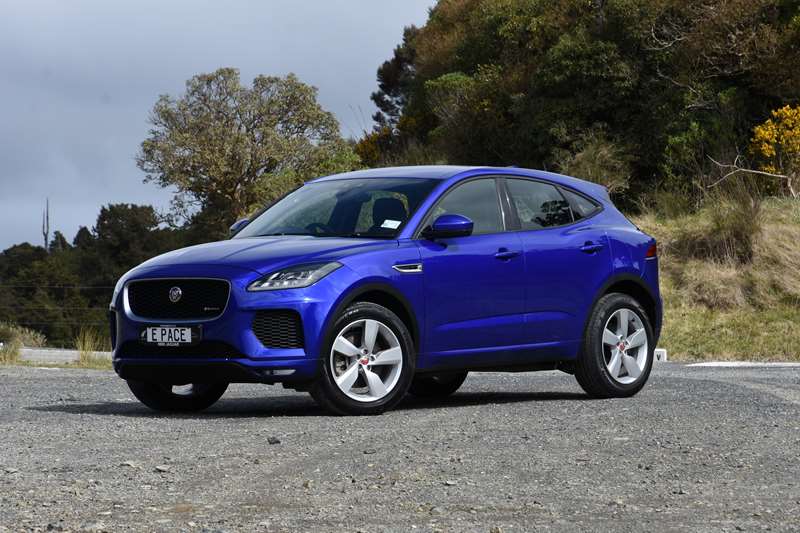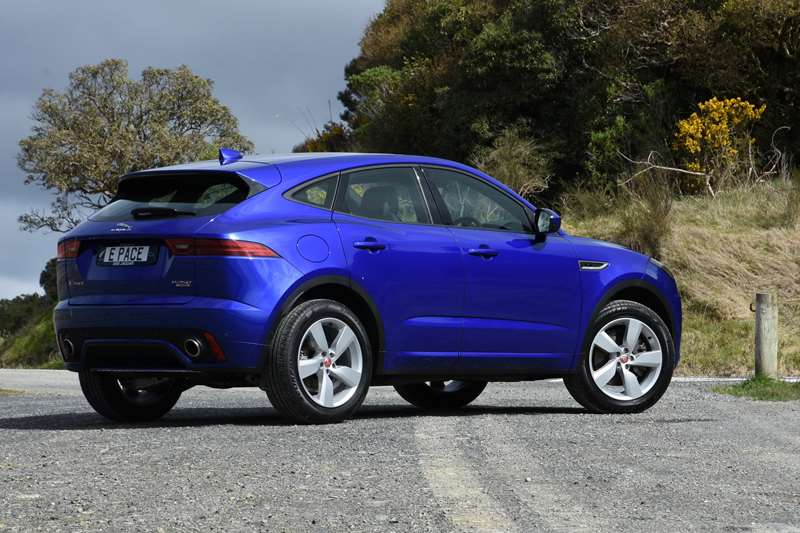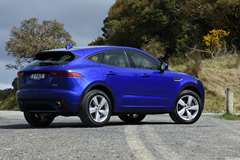| Price: | 79900 |
|---|---|
| Engine: | 1998cc turbo-charged four-cylinder petrol, maximum power 249kW@5500rpm; maximum torque, 365Nm@1200- 4500rpm |
| Transmission: | Nine-speed automatic, all-wheel drive |
| Safety: | Five-star European NCAP |
| Wheels and tyres: | Alloy wheels, 235/55 R19 tyres |
| Fuel and economy: | 7.7 litres per 100km on European combined cycle, capacity 69 litres |
| Emissions: | 174g CO2/km |
| Dimensions: | Length 4395, width 1984, height 1649 |

What We Like
- Handsome styling
- refinement when cruising
- engine’s top-end character

What We Don't
- A few expected items missing from standard specification
- handling lacks a little polish
Verdict
A decent enough effort, likely to help deliver on Jaguar’s bold SUV ambitions
Rating:
Overview
Quintessentially British sports and luxury car-maker, these days owned by Indians, is looking to an Austrian-built SUV to spearhead its drive for increased global sales. Welcome to the 21st-century automotive world and the story of the modern Jaguar, and the E-Pace.
No matter what a brand’s heritage, it’s now impossible to succeed on the international stage without providing sports utility options. Never mind the SUV options now on offer by Jaguar’s obvious rivals, Audi, BMW, Lexus, Mercedes and Volvo, just look at Bentley, Ferrari, Rolls-Royce and Lamborghini — all now either have SUVs in their range or on the way.
Jaguar took its first steps in this direction a couple of years ago with the mid-sized F-Pace. Now a second, more compact model — the E-Pace — has joined the line-up.
As part of a wider automotive grouping that includes Land Rover, Jaguar had a ready source of SUV underpinnings for the E-Pace — it is based on a modified version of the platform used for Land Rover’s Evoque and Discovery Sport, and sits somewhere between the two in terms of size.
Worldwide, the E-Pace is set to become Jaguar’s best-selling model, with 80% of buyers being first-time Jaguar owners. The company isn’t talking specific targets for New Zealand, but in launching the E-Pace as a range comprising a mix-and-match of petrol and diesel engine choices and three levels of trim, its intent is clear.
Those engines comprise two 2 litre turbodiesels (150kW/380Nm and 180kW/430Nm), and a two 2 litre turbopetrol (250kW/365Nm or 300kW/400Nm). Trim levels are
S (150kW diesel and 250kW petrol engines), R-Dynamic S (180kW diesel or 250kW petrol) and R-Dynamic SE (180kW diesel or 300kW petrol).
Prices start at $69,990 for the E-Pace D150 S and run to $89,900 for the flagship E-Pace P300 R-Dynamic SE. All models feature four-wheel drive as standard, along with a nine-speed automatic transmission equipped with paddleshifts.
Jaguar supplied the mid-range $79,900 P250 R-Dynamic S for appraisal.
Visually, the R-Dynamic S differs from the entry level S in having body-coloured door cladding, front fog lamps, twin tailpipes and a sportier nose and front grille with a metallic surround and subtle R-Dynamic badging. It also sits on 19-inch alloys and 55-profile tyres.
The E-Pace is taller than many of its rivals and this, along with a large grille and blunt, upright nose, makes it appear larger than it actually is. A similar impression is conveyed from behind the wheel and, to a lesser extent, from the rear seats, which rate well for shoulder and head room for a vehicle of this size.
The boot isn’t quite as capacious, though its capacity is still good, and its split load cover is cleverly configured to provide out-of-sight security with a minimum of fuss.
A power-operated tailgate is reserved for the top-flight SE variant. This, along with the absence of keyless entry, adaptive cruise control, and passenger grab handles above the doors are odd omissions for a mid-spec model.
Comfort and convenience features that did come as standard on the test car included leather trim, power adjusting heated front seats, dual zone climate control and metal scuff plates. There’s also 360-degree camera, rear cross traffic alert, lane-keeping assist and parking assist functions but, once again, a step up to the SE is required to secure blind spot monitoring and high-speed emergency braking.
The test car’s 10-inch centre touchscreen was an absolute delight. Mounted low on the dash, the system’s home menu gives access to satellite navigation, media and phone functions. A simple screen-swipe activates sub-menus for economy data, web browsing, contacts, live system (news, notifications, weather, flight tracker), voice control set up and valet mode.
Bluetooth connectivity is seamless and plugged connectivity is provided via dual USB charge points in the lidded bin between the front seats.
The cabin is lifted visually by extensive double stitching on the many leather and faux leather surfaces, and although there are hard-touch plastics lower down, the quality of materials, fit and finish is generally very good.
The E-Pace’s height ensures a command-style driving position. Visibility is especially good forwards and to the side, although somewhat restricted to the rear.
Selectable via a switch beside the gear shift, the E-Pace provides eco, comfort, dynamic and soft-surface (rain/ice/snow) drive modes, with engagement of the latter requiring an additional confirmation step.
Initial impressions were of a vehicle that is solid and easy-going, but not as mechanically lively as expected. Ride quality and general comfort were good and noise levels — aside from the inevitable coarse-chip road rumble — well contained.
The test car’s felt sure-footed and the brakes were excellent, but the steering offered little feedback, and hard cornering provoked a combination of body roll and understeer.
Enthusiasts who, like me, have long admired Jaguar for its sports and luxury cars, may find themselves frustrated by aspects of the new E-Pace. Yet these frustrations are, in part, an entirely predictable outcome of a first step into the compact SUV segment by a brand that has traditionally shunned vehicles of the type that are now key to its success.








